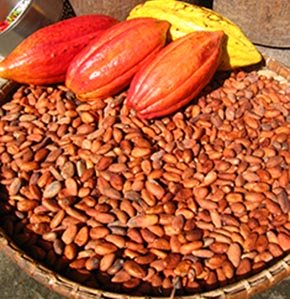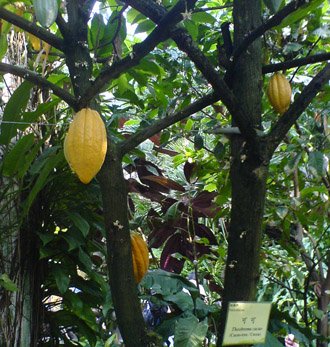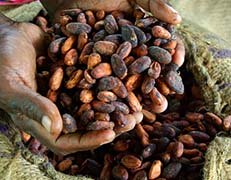Cocoa Beans (Chocolate Beans) Nutrition facts
Flavorful cocoa beans represent another gift from Mexicans to the world, much like vanilla beans, peppers, potatoes, and tomatoes. These beans, extracted from cocoa fruits (pods), undergo further processing to yield cocoa powder and cocoa butter, two highly valued products in commodity markets.
Binomially, cocoa plant belongs to the Malvaceae or mallow family of flowering plants. Other notable members of this family include durian, okra, cotton, and kola nuts.
Scientific name: Theobroma cocoa.
 |
| Cocoa pods and dry beans Photo courtesy: Lolay |
 |
| Cocoa pods on a tree. Photo courtesy: Denise Chan |
It is a tropical, evergreen, medium-sized tree with bright, glossy leaves that thrives in a tropical, humid climate but requires shady coverings to flourish. When mature, the cultivated cacao tree stands between 15 and 25 feet tall, although it can reach heights of 50 feet or more in the wild.
Cocoa pods begin to appear in the third year of plantation and continue to yield fruits for up to 30 years. These pods emerge on the trunk similar to jackfruits. Immature pods are green or maroon, transitioning to bright yellow and orange as they mature.
While numerous cocoa cultivars exist worldwide, only three varieties are renowned for their unique fragrance and commercial significance: Criollo, Forastero, and Trinitario. Criollo represents a high-quality grade of cocoa distinguished by its exceptional flavor and aroma, while Trinitario is a hybrid of Criollo and Forastero strains.
The pods are oblong in shape with ribs on the outer rind resembling pumpkins, measuring approximately 5 to 14 inches in length and 3 to 6 inches in breadth.
Health Benefits of Cocoa Beans
Cocoa beans, similar to vanilla beans and saffron, are highly prized non-pungent condiment ingredients, especially employed as flavoring agents in a wide array of confectioneries.
These beans carry high calories due to their high fat content. Cocoa solids, a byproduct of cocoa mass after extracting cocoa butter, on the other hand, are very low in calories.
Cocoa powder contains minerals and phytochemicals at higher concentrations that were nearly absent in the cocoa butter.
Cocoa solids contain phytochemicals: theobromine and caffeine. However, their levels are significantly lower than those found in coffee powder.
Theobromine and caffeine act as nervous system stimulants and function as mood elevators.
Additionally, cocoa contains phenolic antioxidants such as catechins, anthocyanidins, and pro-anthocyanidins. Research studies suggest that these chemical compounds, owing to their antioxidant properties, counteract cancers, inflammation, aging, and viral infections.
Its solid extracts contain significant amounts of B-complex vitamins such as niacin, pantothenic acid, thiamin, riboflavin, and vitamin B-6. These vitamins aid in enzyme synthesis, nervous system function, and regulation of body metabolism.
Furthermore, the solids also boast an excellent composition of minerals such as iron, selenium, calcium, magnesium, potassium, manganese, and zinc. Selenium, abundantly found in these beans, is cardio-protective and acts as an antioxidant.
| Principle | Nutrient Value | Percent of RDA |
|---|---|---|
| Energy | 228 Kcal | 11% |
| Sugars | 1.75 g | 1% |
| Protein | 19.60 g | 35%% |
| Total Fat | 13.70 g | 46% |
| Cholesterol | 0 mg | 0% |
| Dietary Fiber | 37 g | 97% |
| Vitamins | ||
| Folates | 32 mcg | 8% |
| Niacin | 2.185 mg | 13% |
| Pantothenic caid | 0.254 mg | 5% |
| Pyridoxine | 0.118 mg | 9% |
| Riboflavin | 0.241 mg | 18% |
| Vitamin A | 0 IU | 0% |
| Vitamin C | 0 mg | 0% |
| Electrolytes | ||
| Sodium | 21 mg | 1.5% |
| Potassium | 1524 mg | 32% |
| Minerals | ||
| Calcium | 128 mg | 13% |
| Copper | 3.837 mg | 426% |
| Iron | 13.86 mg | 173% |
| Magnesium | 499 mg | 125% |
| Manganese | 3.837 mg | 239% |
| Phosphorus | 734 mg | 105% |
| Selenium | 14.3 mcg | 26% |
| Zinc | 6.81 mg | 62% |
Processing
 |
| Dry cocoa beans ready for export. Sourcs: Dept. of foreign affairs and trade. |
Most buyers are unaware of how cocoa powder and cocoa butter are produced. Farmers in the plantation harvest mature cocoa fruits and manually extract beans from pods, which then undergo a week-long fermentation process.
Subsequently, the beans are dried in sunlight for a couple of days until they become completely dry and shriveled. At the warehouse, they are further cleaned and graded before being dispatched to the markets for sale. In processing units, the whole cocoa beans undergo gentle roasting and de-hulling before yielding the two primary products: cocoa butter and cocoa powder.
Selection and Storage
Cocoa pods and dry beans are seldom found outside of their growing regions. However, buyers can readily find processed cocoa bean products such as cocoa powder and butter in stores.
When purchasing unsweetened cocoa powder from nearby supermarkets, it is crucial to be vigilant about adulteration. Look for an authentic brand that clearly displays its source and provides complete nutritional information. Dutch-processed cocoa, while having a neutral pH, is inferior in terms of antioxidant quality compared to naturally processed cocoa powder.
Seek for powder with a higher fat percentage. If unsure about immediate usage, refrain from opening the sealed cocoa powder pack. Instead, store the unopened pack in an airtight jar in a cool, dark place where it can remain fresh for a couple of months. Likewise, store cocoa butter in a dark jar in a cool, dry area away from sunlight.
Culinary Applications
Unsweetened cocoa powder possesses a dark brown hue and a bitter taste, making it unpalatable on its own. Confectioners typically blend it with milk solids and sugar to create delectable treats!
Here are some serving tips:
Ancient Mexicans used to drink pure cocoa extract without adding milk or sugar and found it to be healthy, aphrodisiacal, and refreshing.
Cocoa powder and cocoa butter are highly sought-after ingredients in the chocolate industry worldwide.
Cocoa powder and solids are employed in cookies, fudge, cake, muffins, ice creams, etc.
Cocoa butter is used in all types of chocolates and is attributed to its glossy surface, creamy texture, and melting properties.
Safety Profile
Allergic reactions to pure cocoa bean products are generally rare. However, chocolate allergies are sometimes attributed to the presence of milk and nuts mixed in them. (Medical disclaimer)
≻≻-Back to Home page.
Further Resources:
World Cocoa Foundation. Pdf.
Stanford School of Medicine Cancer information Page- Nutrition to Reduce Cancer Risk.